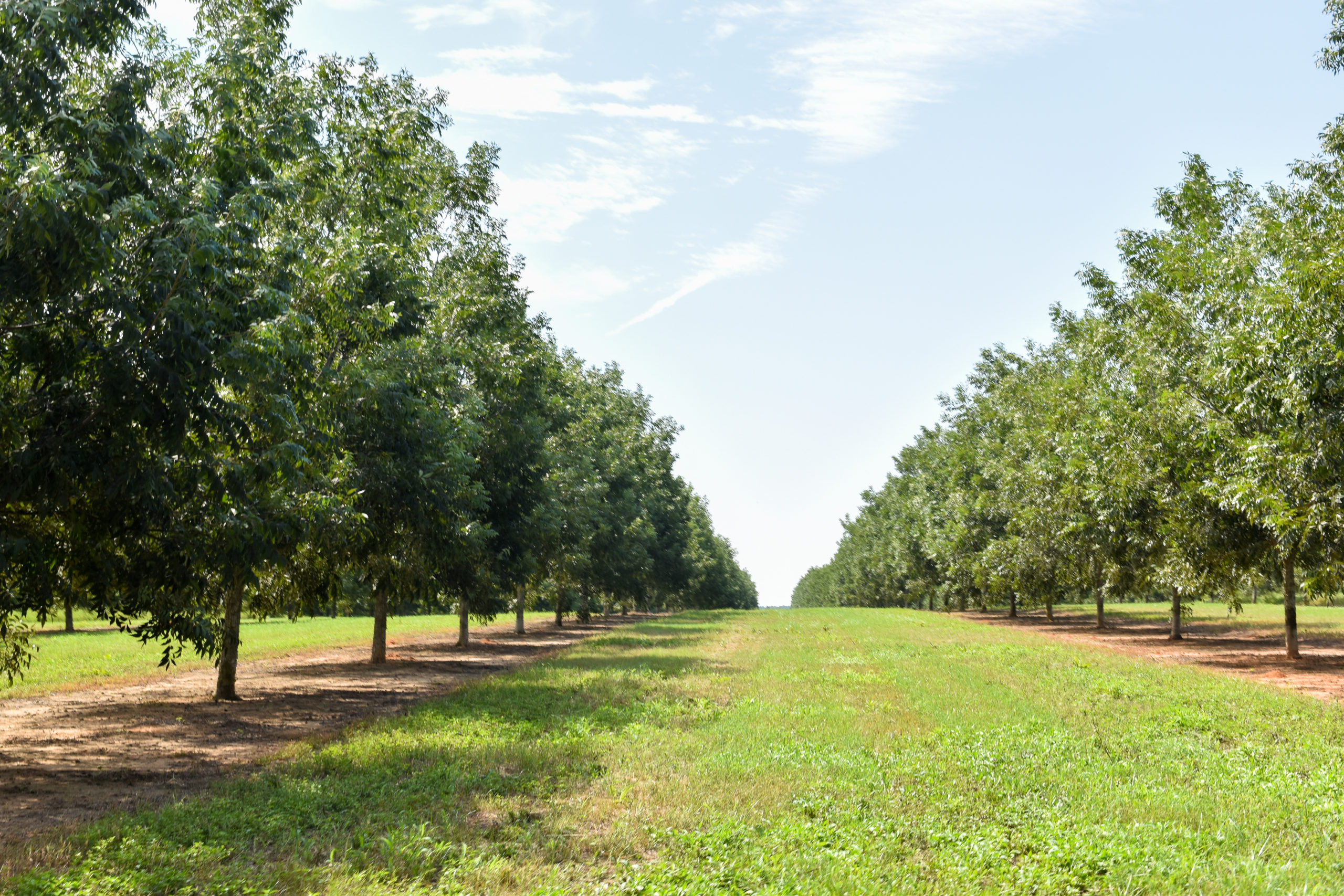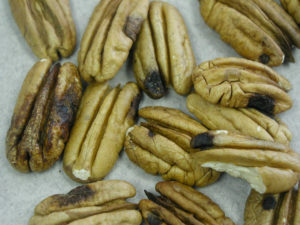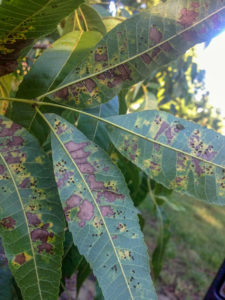5 Late-Season Tips for Your Pecan Crop

Rows of pecan trees work to develop a crop at King Springs Pecans, in September 2019 at the Georgia Pecan Growers Association's Fall Field Day. (Photo by Catherine Clark)
1. Water Your Pecans
The first late-season tip is to focus on watering your pecans. We are still at peak water demand for pecans. Until kernel filling is complete, you need to continue irrigation at full capacity. This means you need 3,600 to 4,000 gallons per acre per day, preferably applied within 12 hours. Irrigate at 100 percent until at least mid-September. Check kernel fill at that time, and if it’s not complete, continue with full irrigation. Once kernel fill is complete, you can cut back to 40 to 50 percent of your whole cycle.
Pecans need adequate water through shuck split for the nut to mature and open properly. Failure to provide adequate soil moisture as the kernel matures beyond filling leads to fruit abortion, shuck decline, tuliping, stick-tights, and poor quality.
If your trees are overloaded, there is a good chance you will see these problems even with irrigation if the weather stays hot and dry through September and October. Under these conditions, irrigation alone may not be sufficient to mature the crop. You should continue watering at 40 to 50 percent irrigation until three to five days before tree shaking. If the weather remains hot and dry through September and into October, this extra amount is especially critical, and you may even need to go up to as much as 70 percent of your full capacity.
2. Control Stink Bugs & Leaf-Footed Bugs

After shell hardening, stink bugs’ feeding results in dark, circular spots on pecan kernels and lowers crop quality. (Photo by Lenny Wells)
At this stage in the reason, you also want to monitor for pests. Stink bugs and leaf-footed bugs are notorious late-season pests, which can significantly damage your crop without you even realizing it until its too late. Southern green stink bugs, brown stink bugs, and leaf-footed bugs all forage in the tree canopy throughout the season. Until shell hardening is complete, these pests typically knock nuts off the tree as they feed. Perhaps the most insidious damage they cause occurs after shell hardening. At that point, their feeding causes dark, circular spots on pecan kernels.
Stink bugs’ mobility makes them challenging to manage. They tend to forage over relatively vast areas. These pests may be in an orchard one minute, the adjacent row crop field the next, and then in the understory of the orchard. Stink bugs and leaf-footed bugs will continue to feed on mature nuts even after shucks split. Of course, at that point, it is too late to treat for them. However, up to shuck split, growers should regularly scout for these pests.
Begin treating when you find one stink bug per 40 terminals, or when you find five or more per knockdown spray on a sheet covering 20 percent of the area under a tree. Sprays for these insects are difficult to time properly because the bugs move in and out of orchards so readily. Detecting damaging populations requires close checking. Although no materials have consistently given excellent stink bug control, possibly due to the difficulty in timing sprays, pyrethroids are the best option. Of these, Bifenthrin has shown the greatest efficacy.
3. Manage Aphids and Mites

When feeding on pecan leaves, black aphids cause chlorotic lesions on foliage. These lesions eventually turn brown like on this leaflet and can lead to major defoliation. (Photo by Lenny Wells)
When reviewing their insect management late in the season, growers should mind this third tip: control aphid populations to prevent economic loss. As you spray for weevils and stink bugs, you will unavoidably generate a resurgence of aphids and mites as the pyrethroids wipe out most insects in the orchard, including beneficials. You’ll kill most of the aphids with these sprays as well. But those that do survive will reproduce quickly in the absence of predators, as will the mites. Throughout most of this month, you should continue to monitor these pests closely. This is especially true for black aphids. I don’t worry so much about yellow aphids this late, and in my opinion, as you get close to the end of September, you should quit even scouting for these pests because they are not likely to do enough damage between the end of September and harvest to significantly affect the crop or trees.
4. Be Careful When Shaking ‘Pawnee’
The fourth late-season tip relates to tree shaking, specifically shaking ‘Pawnee.’ The 2020 Georgia crop appears to be significantly ahead of schedule this year, and I imagine we will be harvesting ‘Pawnee’ by mid-September. Keep in mind that your management schedule for ‘Pawnee,’ including irrigation, will be about a month ahead of your other cultivars at this point. So, continue to irrigate through shuck split.
‘Pawnee’ can present a problem when shaking because the nut matures very early and harvest occurs when the tree is still conducting water through its tissues. This fact makes it particularly easy to damage the bark of ‘Pawnee’ trees when shaking. To prevent permanent damage, growers should make every effort to shake ‘Pawnee’ trees’ limbs rather than their trunks. Turn off irrigation at least five days ahead of shaking this cultivar so they can
harden off a little, and shake trees in the afternoon rather than the morning when the trees are actively conducting water.
5. Take Stock of the Past Growing Season
Lastly, this month is an excellent time to reflect on the growing season. Many of us have short memories. It’s easier to think about how your management has worked and make a note of it now, rather than trying to remember how well something worked when you’re in the heat of the battle next year.
When reflecting on this past growing season, think about the weather you’ve had, what you’ve sprayed, and how well you think those materials worked. If you have some scab on the nuts, think beyond the materials you have used. Most of the time its an issue other than material. Was the sprayer getting adequate coverage? Look at weather records and align them with your spray records to see if there was a time in which maybe you should have gone to 10 days instead of 14 days. Maybe you had rain within an hour after you stopped spraying. These factors can weigh heavily upon your scab management and are often more important than the material you used.
Furthermore, think about all the additional things you’ve added to the spray tank this year. Do you really think they helped you? Hopefully, if you are running a new foliar nutrient or similar product, you have an area in the orchard that you used as a control, which did not receive the product. Does that area look any different than the sprayed area? If so, why? Is it really the spray material, or are there other factors at play?
From cultivar, airflow, sunlight, size of last year’s crop—view everything with a healthy dose of skepticism. These five late-season tips give you some additional things to consider when approaching harvest. With the uncertainty in the market, you need to be sure you are getting your money’s worth for every dime you put into the orchard.

